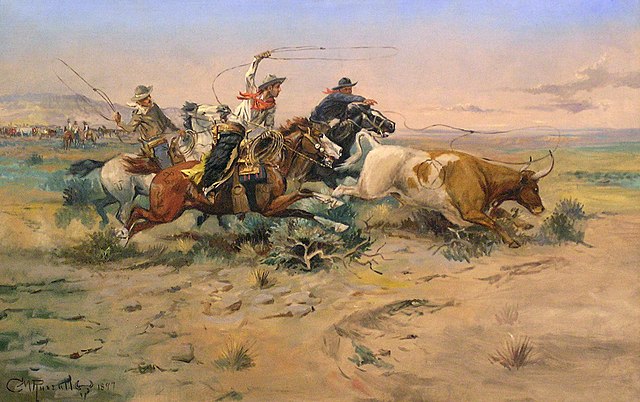Herder
Person who herds domestic animals From Wikipedia, the free encyclopedia
A herder is a pastoral worker responsible for the care and management of a herd or flock of domestic animals, usually on open pasture. It is particularly associated with nomadic or transhumant management of stock, or with common land grazing. The work is often done either on foot or mounted.

Depending on the type of animal being herd, the English language can give different professional names, for example, cowboy for cows, shepherd for sheep, or goatherd for goat.
Terminology
Herders may be distinguished by sex (e.g., herdsman, herdswoman or herdboy) or by the type of livestock, for example camelherd, cowherd, duckherd, goatherd or shepherd.[1]
By country
China
Tibetan herding communities living in the Tibetan Plateau in the Sichuan Province of southwest China continued to graze herds on common lands even after the 1982 Household responsibility system. Several reasons have been given for the endurance of the traditional pastoral lifestyle:[2]
- complex topography prevents the division of common grazing lands among individual households
- yaks require free grazing and become ill in fenced pasture
- rotation of grazing spots
Grassland degradation has been an issue. Herding communities and their leaders have taken steps to reach a consensus about sustainable grazing practices. These include developing the community political organization to enforce commitments to seasonal rotational grazing.[2]
By livestock type
Summarize
Perspective
Cows

A cowboy is an animal herder who tends cattle on ranches in North America, traditionally on horseback, and often performs a multitude of other ranch-related tasks. The historic American cowboy of the late 19th century arose from the vaquero traditions of northern Mexico and became a figure of special significance and legend.[3] A subtype, called a wrangler, specifically tends the horses used to work cattle. In addition to ranch work, some cowboys work for or participate in rodeos. Cowgirls, first defined as such in the late 19th century, had a less-well documented historical role, but in the modern world work at identical tasks and have obtained considerable respect for their achievements.[4] Cattle handlers in many other parts of the world, particularly South America and Australia, perform work similar to the cowboy.
The cowboy has deep historic roots tracing back to Spain and the earliest European settlers of the Americas. Over the centuries, differences in terrain and climate, and the influence of cattle-handling traditions from multiple cultures, created several distinct styles of equipment, clothing and animal handling. As the ever-practical cowboy adapted to the modern world, his equipment and techniques also adapted, though many classic traditions are preserved.There are numerous regional types of cow herder, many with a specific name; these include the stockman of Australia, the buttero, campino, csikós, gardian and gulyás in Europe, the buckaroo, charro, cowboy and vaquero in North America, and the gaucho, huaso, llanero, morochuco and qorilazo of South America.
Goats

Sheep


A shepherd is a person who tends, herds, feeds, or guards flocks of sheep. Shepherding is one of the world's oldest occupations; it exists in many parts of the globe, and it is an important part of pastoralist animal husbandry.
Because the occupation is so widespread, many religions and cultures have symbolic or metaphorical references to shepherds. For example, Jesus called himself the Good Shepherd,[6] and ancient Greek mythologies highlighted shepherds such as Endymion and Daphnis. This symbolism and shepherds as characters are at the center of pastoral literature and art.See also
Look up herder in Wiktionary, the free dictionary.
Wikimedia Commons has media related to Herders.
References
Wikiwand - on
Seamless Wikipedia browsing. On steroids.
